Adelaide Attentiveness Measurement: $1,000 Of AM/FM Radio Ads Require $2,635 Worth Of Facebook Ads To Achieve The Same Level Of Attention; Audio Platforms Generate Nearly The Same Attentiveness As TV
Click here to view a 13-minute video of the key findings.
Click here to download your copy of the Media Attentiveness and Ad Skipping Report.
Are 1,000 impressions on social media the same as 1,000 impressions on TV, online video, or AM/FM radio? Adelaide, an attentiveness measurement firm, says no. They conclude there is a significant difference in advertising attention across media platforms.
The Advertising Research Foundation defines advertising attention as “the degree to which those exposed to the advertising are focused on it.” Adelaide measures how ads on media platforms get noticed, hold attention, and impact memory.
Adelaide’s “Attention Unit,” or AU score, compares advertising attention by media. An analysis of Adelaide’s AU scores reveals what would have to be spent on other media to achieve the same attentiveness of a $1,000 AM/FM radio advertising investment:
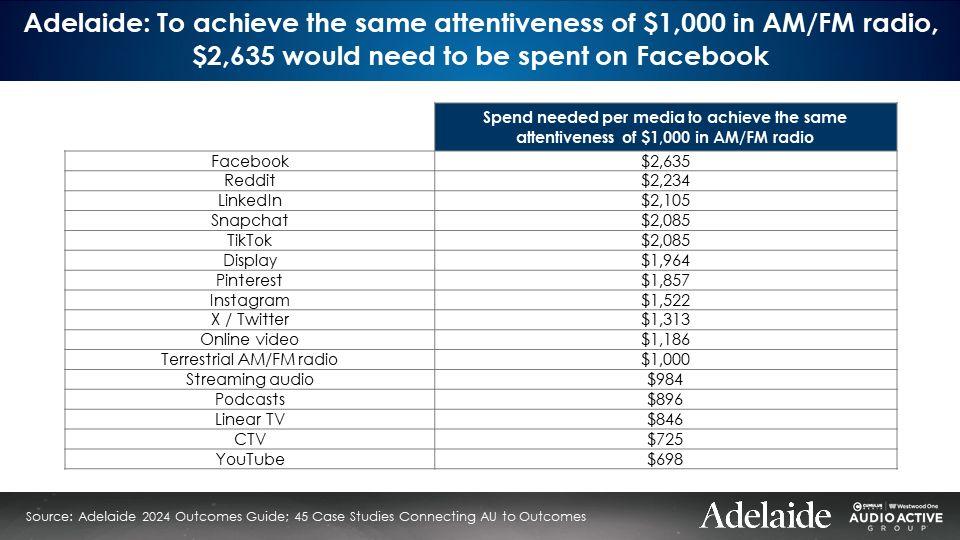
In order to achieve the same degree of AM/FM radio advertising attention, twice as much would have to be spent on display digital ads, TikTok, Snapchat, LinkedIn, and Reddit. Platforms such as YouTube and connected TV would require less than $1,000 to match the attentiveness of a $1,000 AM/FM radio ad investment.
Adelaide AU scores: Despite the lack of “sight and motion,” audio platforms generate nearly the same attentiveness as TV
These new findings from Adelaide decisively smash the myth that ads with “sight, sound, and motion” are significantly more effective than audio ads. This is the latest in a series of studies that reveal audio attention is much closer to video and visual ad formats than previously suspected.
“We’re seeing a lot of demand for placement quality data from both sides of the audio market. The strong performance of audio formats challenges long-held assumptions and offers marketers a compelling opportunity to maximize effectiveness,” said Marc Guldimann, CEO and Co-Founder at Adelaide.
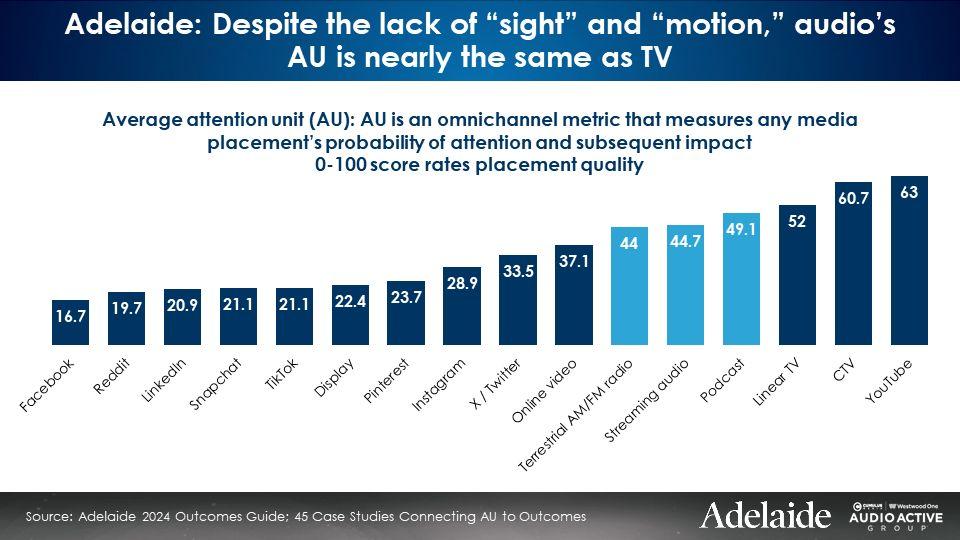
- AM/FM radio has 85% of the attentiveness of linear TV at one-fourth the CPM
- Streaming audio has 86% the attentiveness of linear TV
- Podcasts have 94% of the attentiveness of linear TV
Lumen: Audio ads outperform video for attention and brand recall
A major study released last year by Lumen, an attentiveness measurement firm, was commissioned by Dentsu, one of the world’s largest media agencies. The Lumen study squashed the myth that video ads are exceptionally more effective than audio ads.
“Audio Ads Outperform Video for Attention and Brand Recall” was the head snapper of the headline in Ad Age. The Lumen study also revealed that audio ad formats were stunningly efficient on an attention CPM basis.
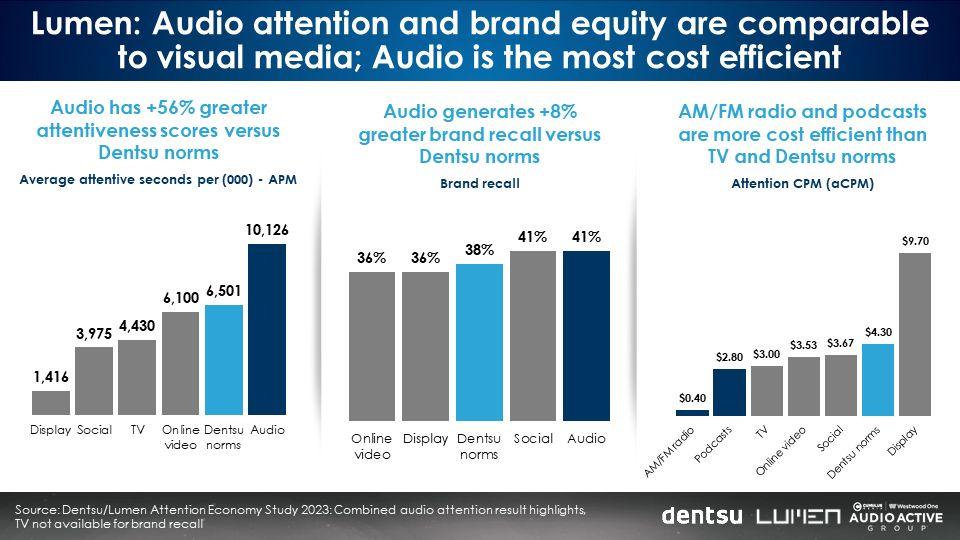
Amplified Intelligence: AM/FM radio sits between social feeds and quality online video in terms of attentive seconds
A major study conducted by attentiveness measurement firm Amplified Intelligence for Commercial Audio and Radio Australia found AM/FM radio beat social and came close to video for attentiveness.
Like all platforms, formats underneath this average can differ. Amplified Intelligence found that branding makes more of a difference on AM/FM radio. Branding causes more variation in outcomes than visual media.
Amplified Intelligences publishes a STAS score which depicts the “short-term advertising strength” index, measuring how an ad effects brand recall and purchase behavior. In their test, they found a wide variation in AM/FM radio’s STAS index by advertiser category.
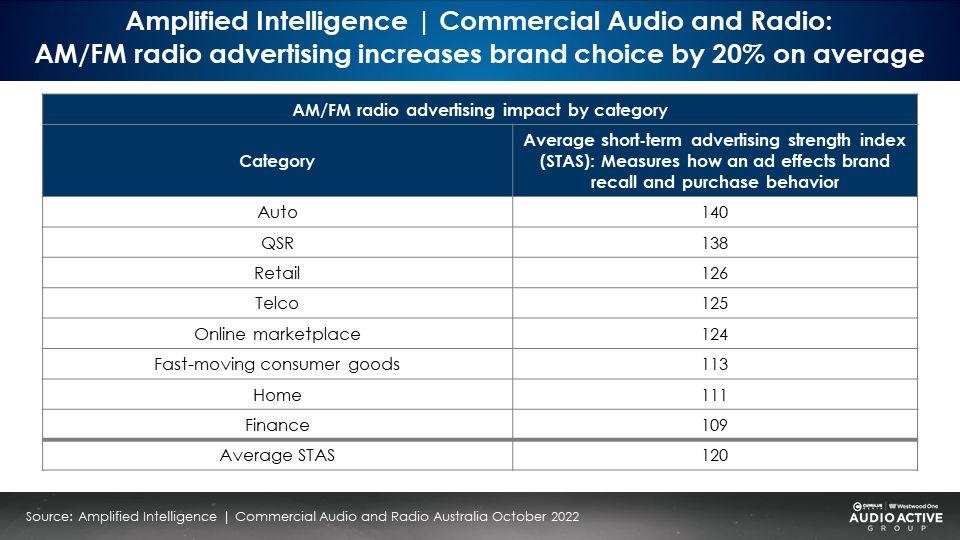
MARU/Matchbox: Audio ad formats have strong attentiveness due to low ad skipping
A major consumer study of 1,617 Americans conducted in April 2024 revealed print, both over-the-air and streaming AM/FM radio, direct mail, music streaming, and podcasts enjoy the lowest levels of ad skipping.
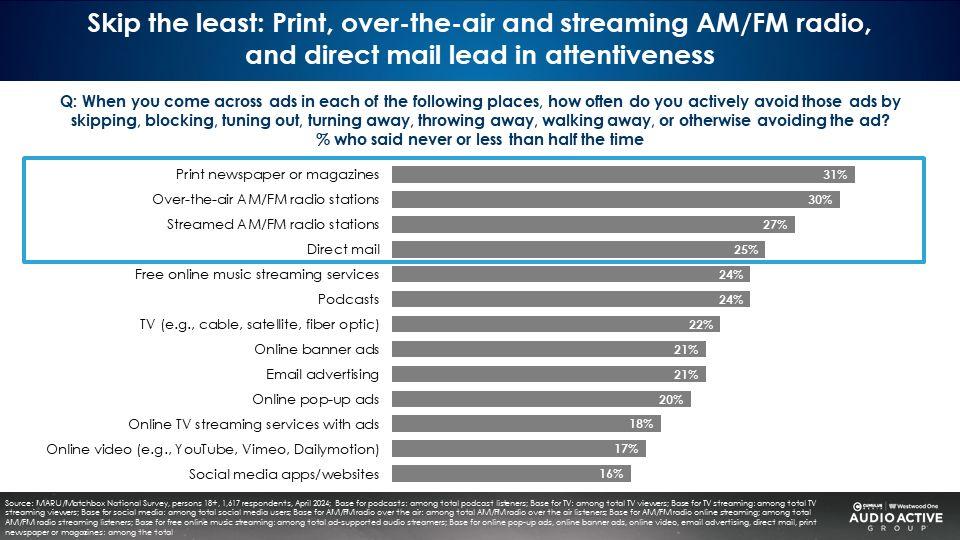
The MARU/Matchbox study reveals the media with the greatest ad skipping are digital ad formats: banner ads, pop-up ads, online video, social media, and emails.
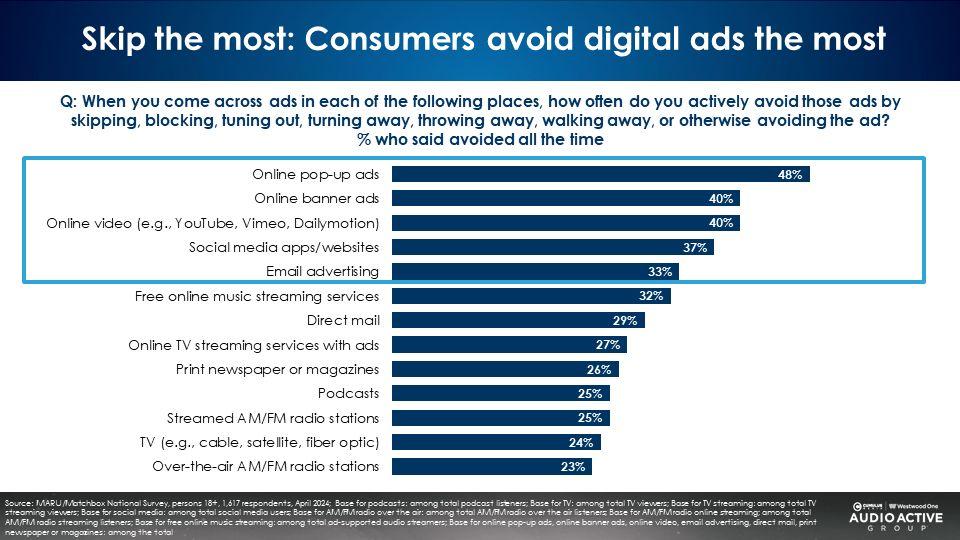
The Association of National Advertisers reveals there are three stages to what they define as the Attention Pathway
- “Get Noticed – advertising requires an environment that fosters attention. This is the job of a media placement. How well it gets that job done is a good indicator of its quality: the best quality placements create the greatest potential for attracting attention.
- Hold Attention – it’s vital to keep the viewer focused on the ad. In some circumstances, this can be measured using duration. This requires a stable media placement and interesting creative.
- Impact Memory – with attention now assured, the creative must deliver a brand message that affects the short- or long-term memory of the person paying attention to the ad.”
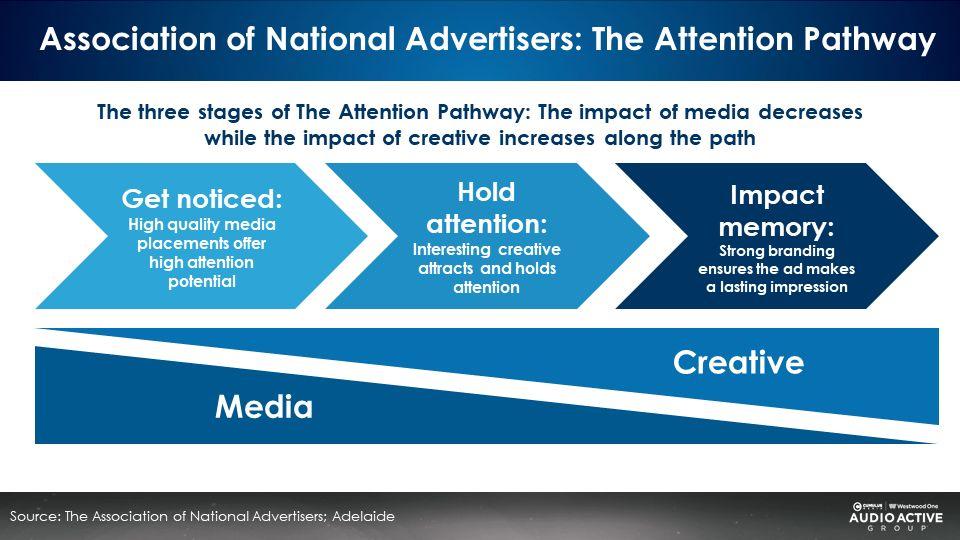
Advertiser Perceptions: 78% of marketers and media agencies say attentiveness is important as a metric for measuring the effectiveness of media investments
The Advertiser Perceptions annual study of attentiveness commissioned by the Cumulus Media | Westwood One Audio Active Group® reveals the importance of attention measurement has grown over the last three years.
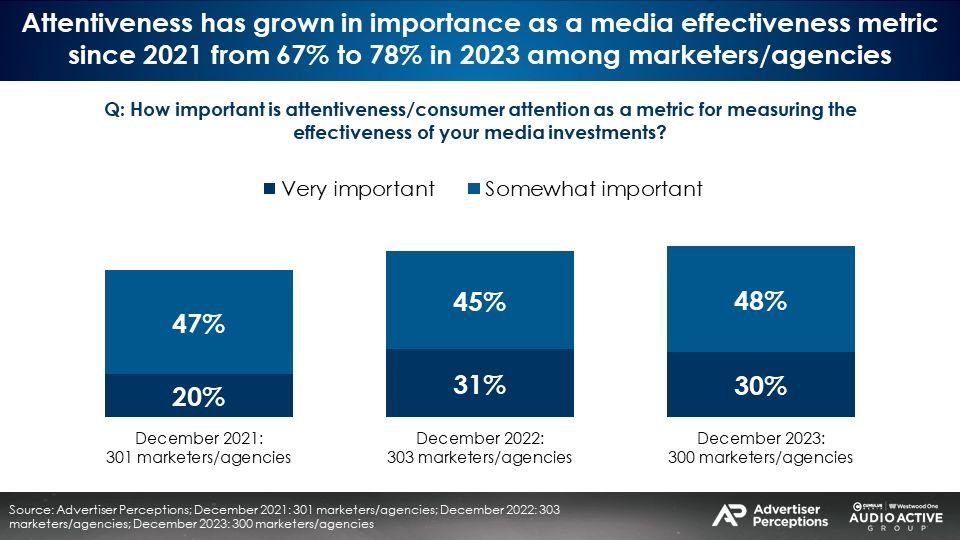
Marketers and consumers agree that podcasts hold extraordinary levels of attention; Media agencies and brands underestimate consumer attention to AM/FM radio
The Advertiser Perceptions study of media agencies and advertisers reveals similar levels of attention to AM/FM radio and music streaming services. Consumers feel otherwise. They indicate a greater degree of concentration to AM/FM radio versus music streaming brands.
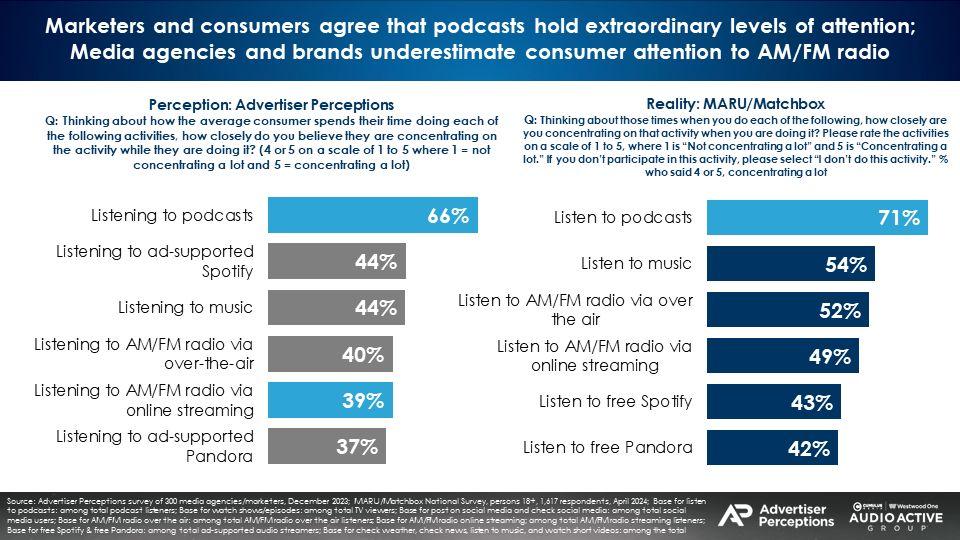
Signal Hill Insights audio need states: Consumers engage with AM/FM radio for information and entertainment; Podcast consumers seek to learn new things; Music streaming is about “relaxing”
Radio Connects’ 2024 “Radio on the Move” study conducted by Signal Hill Insights reveals “get information” is the top need state satisfied by AM/FM radio. Podcasts’ top need state is “learn something new.” Both of these are “lean in,” pay attention listening contexts, which hugely benefit advertisers.
Music streaming services’ top need state is “to relax,” which represents a lean back, play softly in the other room context. Ads in this lean back, relax use case have a harder time being noticed and attaining attention.
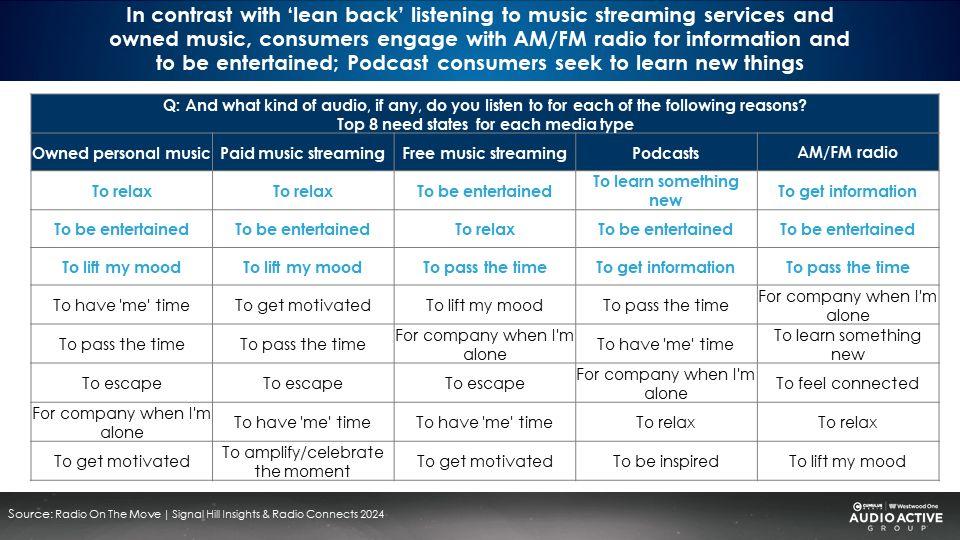
MARU/Matchbox: AM/FM radio programming format attentiveness is high for spoken word content, Spanish, Religious, R&B Hip Hop, and Alternative Rock
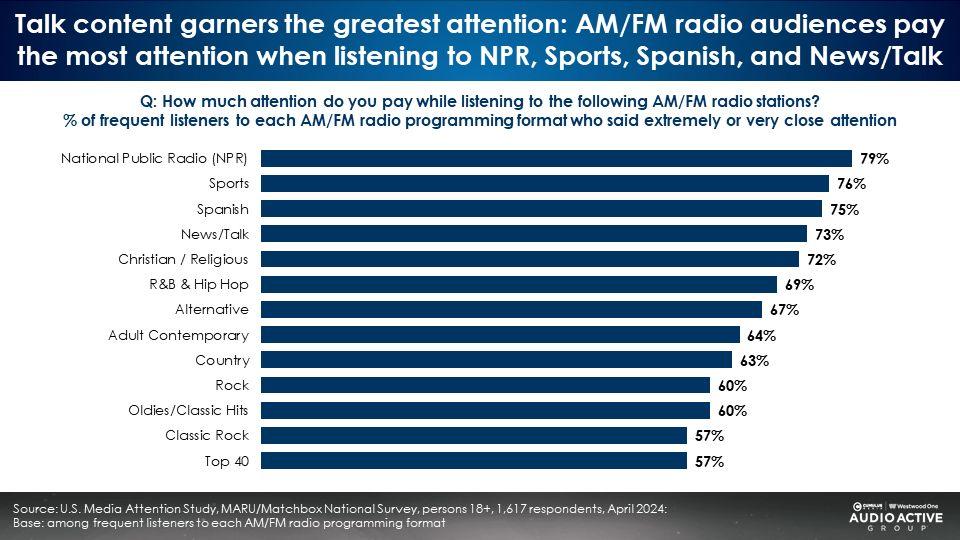
Key findings:
- Adelaide: $1,000 of AM/FM radio ads require $2,635 worth of Facebook ads to achieve the same level of attention. Audio platforms generate nearly the same attentiveness as TV.
- A series of recent studies explode the myth that ads with “sight, sound, and motion” are inherently more effective than audio ads. Lumen’s recent study reveals audio ads exhibit greater attentiveness and brand recall than video. Lumen also reports audio is also the most cost-efficient media on an “attention CPM” basis.
- Attention has grown in importance among marketers and agencies: 78% say attentiveness is important as a metric for measuring the effectiveness of media investments.
- Traditional media ads have greater engagement compared to digital ads: AM/FM radio, print, and podcast ads are skipped the least. Consumers skip digital ads the most.
- Audio platforms satisfy unique need states: AM/FM radio and podcasts are associated with information and entertainment, providing advertisers with high levels of consumer concentration. “Relax” is the leading need state of music streaming.
- Marketers and consumers agree that podcasts hold extraordinary levels of attention. Media agencies and brands underestimate consumer attention to AM/FM radio ads.
Implications:
- Traditional media impressions are worth more than digital impressions. Linear TV, print, and audio enjoy much stronger attentiveness than digital platforms. Consumers notice ads in traditional media more and skip ads less.
- AM/FM radio CPMs should be a premium to Pandora and Spotify. Pandora/Spotify audio impressions are not the same as AM/FM radio impressions since AM/FM radio is a more lean in experience.
- The greater proportion of spoken word content on podcasts and AM/FM radio generates much higher levels of concentration and attentiveness. The information and personalities of podcasts and AM/FM radio satisfy consumer need states for information and learning.
- High CPMs for podcasts are warranted. Podcasts generate high attentiveness levels as they satisfy multiple “lean in” consumer need states: learning and entertainment.
Click here to view a 13-minute video of the key findings.
Pierre Bouvard is Chief Insights Officer of the Cumulus Media | Westwood One Audio Active Group®.
Contact the Insights team at CorpMarketing@westwoodone.com.